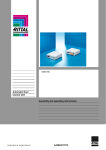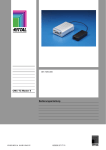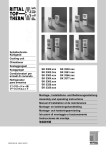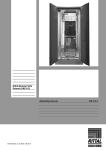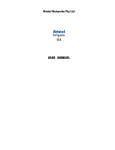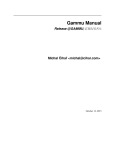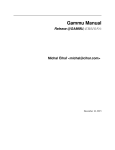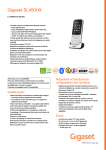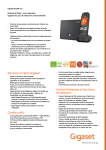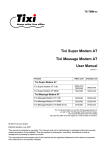Download CMC-TC ISDN Unit Installation and operating instructions
Transcript
CMC-TC ISDN Unit
DK 7320.830
Installation and operating instructions
A31461 04 IT 74
Table of Contents
1.
Description......................................................................................................... 2
2.
Conditions of use / safety-related guidelines ..................................................... 3
3.
Description CMC-TC ISDN Unit 7320.830 front................................................. 5
4.
Description CMC-TC ISDN Unit 7320.830 rear ................................................. 6
5.
Technical specifications..................................................................................... 6
6.
Commissioning .................................................................................................. 7
7.
Settings............................................................................................................ 10
7.1
Via Telnet ..................................................................................................... 10
7.2
Via browser................................................................................................... 13
8.
SMS mode....................................................................................................... 14
8.1
Sending SMSs .............................................................................................. 14
8.2
Receiving SMSs ........................................................................................... 15
Page 1
1. Description
Note:
For reasons of clarity these operating instructions cannot contain all detailed
information, nor can they take into account every conceivable case of installation,
operation and maintenance. Specifications subject to alterations at any time. The
German wording shall apply in cases of doubt.
Accessories:
ISDN Unit 7320.830
IOIOI
Processing Unit:
PU 7320.100 as of software
version 1.21
ISDN
24 VDC
max. 80mA
RJ45 ISDN
connector
Optionally, the ISDN unit can be
supplied from a 24 VDC 80 mA power
source connected here. This is not
necessary when the PU is connected.
Connection cable RJ12/RJ12
(provided)
The CMC-TC ISDN unit can be used to configure a redundant transmission path or,
when no network infrastructure is available, for relaying alarm messages. The alarm
signal is sent as SMS. The ISDN unit is connected to the serial interface on the
processing unit 7320.100. The power supply is likewise achieved via the connection
cable. The device functions only with ISDN (see “ISDN access – requirements”). Up
to four destination call numbers may be set and allocated to the various events.
This variant of sending alarm messages can also be used in countries permitting
SMS in fixed networks. Moreover, SMS can now be used over the fixed network to
control switching outputs.
Power supply is via the processing unit.
Other functions, where offered by the provider:
-
Fax
e-mail:
Voice mail
ISDN access – requirements:
-
DSS1 (Euro-ISDN)
Point-to-multipoint configuration (ISDN S0 bus)
These minimum requirements must also be fulfilled when the ISDN unit is connected
to a private branch exchange.
Page 2
Important information:
•
•
•
•
•
•
•
NOTICE Only one of the tools “ISDN unit”, “GSM unit”, or “display unit” may be
connected to a PU.
NOTICE When the ISDN unit is used, the front interface (RS-232) on the
processing unit is deactivated (e.g. Hyperterminal access). The system
can then be configured only via Telnet or the web.
When Hyperterminal was used before the ISDN unit is installed, the user
must have logged off correctly.
NOTICE When the system is used outside of Germany, it must be
reconfigured to the new circumstances over a telephone link. Our Centre will
be pleased to assist you with further information.
Tel.: +49 (0)2772 505 – 0
Tel.: +49 (0)2772 505 – 2578
NOTICE When more than sixteen unsent messages have accumulated in the
SMS memory, all new outgoing messages will be deleted. These deleted
messages can be viewed in the processing unit via the web or FTP.
Also required:
-
Processing Unit 7320.100
2. Conditions of use / safety-related guidelines
-
-
-
-
-
-
-
-
-
-
Page 3
The CMC-TC ISDN unit must be used exclusively for the Rittal CMC-TC
system.
The following documents apply: the operating instructions / safety-related
guidelines for the processing unit (7320.100) and these product-specific
instructions. In particular, the conditions of use, safety-related guidelines and
warranties listed in these documents must be observed.
It is imperative that all leads are connected separately from cables carrying
the supply voltage.
The CMC-TC ISDN unit must be used exclusively within the specified
environmental limits.
The CMC-TC ISDN unit must not be opened. The unit does not contain any
parts that need servicing.
Before connecting the CMC-TC ISDN unit, make sure that it is suitable for the
processing unit.
Safety devices must not be deactivated.
It is imperative that the CMC-TC ISDN unit does not come into direct contact
with water (e.g. dew), oil, or aggressive substances.
The unit must not be operated in environments subject to flammable gases or
vapours. The unit must be installed in an enclosure/rack to protect it from
water and dust.
There must be no voltage across the CMC-TC system when the CMC-TC
ISDN unit is connected to the PU.
The CMC-TC ISDN unit must be properly installed in accordance with the
separate installation instructions.
-
-
-
Page 4
The conditions of use / safety-related guidelines listed in the instructions must
be observed.
All warranty claims on the grounds of damage become void when this damage
is incurred by failure to observe these instructions / conditions of use or the
instructions for the processing unit 7320.100. Rittal assumes no liability for
consequential damage!
Rittal assumes no liability for any damage to property or bodily injury incurred
by improper use or failure to observe the safety-related guidelines. Every
warranty claim becomes void in such cases!
3. Description CMC-TC ISDN Unit 7320.830 front
ISDN
ISDN unit
1
2
The red/green duo LED (1) indicates the current status of the ISDN unit.
The green LED (2) indicates the connection status of the ISDN unit.
LED
Status
1 (status LED red / green)
red
2 (ISDN LED green)
Meaning
The ISDN unit is being initialised
orange
The ISDN unit is sending or receiving an SMS
green
The ISDN unit is ready
off
After activation the ISDN unit still has no ISDN access
(no terminal endpoint identifier / TEI assigned)
brief flash
The ISDN connector is in the nonoperative state
(TEI assigned, Layer 1 of the ISDN connector is
deactivated)
slowly flashing
(¼ s ON, ¾ s OFF)
The ISDN connector is activated, but the ISDN unit has
not connected
(Layer 1 activated, Layer 2 pending)
slowly flashing
(½ s ON, ½ s OFF)
The ISDN connector is activated, but the ISDN unit has
not connected
(Layer 1 activated and Layer 2 connected)
quickly flashing
(six times a second)
Page 5
The ISDN unit is transferring an SMS or data
4. Description CMC-TC ISDN Unit 7320.830 rear
ISDN
1
1
2
3
2
24 VDC
max. 80mA
3
The provided RJ12/RJ12 connecting lead connects the ISDN unit to this RJ12 connector (RS232 interface) on the processing unit. This connecting lead functions as the 24 VDC supply
and transfers data to and from the processing unit.
The RJ45 ISDN connector is designed for connection to an ISDN connector.
The 24 VDC voltage connector is designed for future developments of the CMC-TC system
and is not needed for running the processing unit.
5. Technical specifications
Maximum power consumption: 80 mA
Maximum connecting lead length: 4 m (processing unit to ISDN unit)
Rated voltage 24 VDC with supply link from the processing unit
Shock resistance 1 g
Operating temperature range: +5° C to +45° C
Protection category. IP 40
ISDN connector: DSS1 (Euro ISDN), multi-point interface
Page 6
6. Commissioning
Warning: The following description applies to software version 1.21 and higher for
the processing unit (DK 7320.100) needed to operate the ISDN unit.
Commissioning
When several SMS terminals are operated on an ISDN bus, each of these SMS
terminals (and therefore every ISDN unit as well) must be assigned its own call
number for sending and receiving SMSs.
Note: The following must be observed before transferring SMSs over the fixed
network.
(This is necessary only when an SMS command is to be sent to the ISDN unit.
Receiving SMS “alarm” messages does not require registration.)
Registering at a network provider requires that an SMS is sent once only to this
provider (for example for Deutsche Telekom: the text "ANMELD" is sent to the call
number "8888"). See the section “ISDN command” below.
The following data must be entered before the ISDN unit is connected to the
processing unit.
Mandatory data:
PIN GSM-Card
This field is not needed to configure the ISDN unit.
Service Centre GSM:
This field is not needed to configure the ISDN unit.
ISDN MSN:
The MSN (multiple subscriber number) is assigned by the network provider.
Also the country code and the local area code must be entered (separated by “/”).
Example: +49/2772/570126
ISDN Command:
Before an SMS can be sent over the fixed network, the ISDN unit must be registered
at an SMS centre. (This is necessary only when an SMS command is to be sent to
the ISDN unit. Receiving SMS “alarm” messages does not require registration.)
The Deutsche Telekom SMS Centre requires an SMS containing the text “ANMELD”
to be sent to the number 8888.
Enter "8888 ANMELD" in the "ISDN Command" field. The ISDN unit then sends this
message to the SMS centre.
When the ISDN unit is not to receive SMS messages any longer or is to be operated
at another connector, the “8888 ABMELD” command sent to Deutsche Telekom
cancels the registration.
Page 7
Unit Messages:
When this option is enabled, unit messages are also sent as SMSs (e.g. timeout,
configuration change, etc.). This SMS is sent to all destination numbers.
SMS Phone Number
Here you can enter the destination call numbers that are to receive SMS messages
sent by the ISDN unit.
Prefixing the destination call number by "F" (the letter F followed by a blank) causes
the SMS to be sent over the fixed network.
Example: F 027725052578
When the destination call number is entered without the prefix "F", the SMS will be
sent to an SMS centre in accordance with the respective mobile network protocol.
Example: 027725052578
The costs differ depending on whether an SMS is sent over the fixed network
or via mobile network operators.
SMS-Info:
This shows the current status.
The ISDN unit can have the following statuses.
ISDN unit found
ISDN unit was found.
ISDN unit o.k.
ISDN unit was recognised and initialised,
ISDN connector is OK.
MSN missing
No MSN was entered.
ISDN no Line
No ISDN network available
(e.g. ISDN cable not connected).
no SMS unit found No SMS unit connected.
SMS unit timeout SMS unit disconnected from processing unit.
Receive SMS
SMS received.
Every sensor and every output can be assigned a list of destination call numbers that
an SMS is sent to (every status change leads to an SMS message). This list can be
created via the menu item ”Sensor Units > Unit xyz > Sensor abc > Send SMS”. Here
you can enter a string consisting of a list of call numbers separated by the character
"&" (e.g. "1&4" sends an SMS to the destination call numbers 1 and 4 when there is a
change to the affected sensor status).
These entries can also be edited and readjusted after the first start-up.
Notes on first start-up
The ISDN unit must not be connected until all details have been stored in the PU.
Please switch OFF the PU, connect the ISDN unit, and switch ON the power supply.
The CMC-TC/PU software polls the interface regularly for the presence of a device. It
may take up to a minute until the ISDN unit is found.
First, the ISDN unit is initialised (status LED lights up red). When the ISDN unit
connects to the network for the first time, the ISDN LED flashes green (cf page 4).
Once the ISDN unit has been initialised, the system continually checks whether there
has been a change to a sensor or output status. When this sensor has been
assigned one or more destination call numbers, an SMS will be sent to these target
addresses.
Page 8
In addition, the system checks whether an SMS has been received. On detection of
an SMS this is examined and, when the syntax is correct, the corresponding action
initiated. The system also checks whether the sender’s phone number is on the list of
destination call numbers. The action is initiated only when this is the case.
The ISDN connection to the switching centre is constantly checked. In the event of an
error, the status LED lights up red.
Page 9
7. Settings
7.1 Via Telnet
The menu "General configuration / SMS configuration" lets you enter the following
values needed for the ISDN unit.
ISDN MSN:
The MSN (multiple subscriber number) is assigned by the network provider.
Also the country code and the local area code must be entered (separated by ”/”).
Example: +49/2772/570126
ISDN Command:
Before an SMS can be sent over the fixed network, the ISDN unit must be registered
at an SMS centre. (This is necessary only when an SMS command is to be sent to
the ISDN unit. Receiving SMS “alarm” messages does not require registration.)
The Deutsche Telekom SMS Centre requires an SMS containing the text “ANMELD”
to be sent to the number 8888.
Enter "8888 ANMELD" in the "ISDN Command" field. The ISDN unit then sends this
message to the SMS centre.
The "8888 ABMELD" command cancels the registration.
SMS Unit Messages:
When this option is enabled, unit messages are also sent as SMSs (e.g. timeout,
configuration change, etc.). This SMS is sent to all destination numbers.
SMS Phone Number
Here you can enter the destination call numbers that are to receive SMS messages
sent by the ISDN unit.
Prefixing the destination call number by "F" (the letter F followed by a blank) causes
the SMS to be sent over the fixed network.
Example: F 027725052578
When the destination call number is entered without the prefix "F", the SMS will be
sent to an SMS centre in accordance with the respective mobile network protocol.
Example: 027725052578
The costs differ depending on whether an SMS is sent over the fixed network
or via mobile network operators.
Page 10
Fig. 1 Telnet configuration of ISDN parameters
Fig. 2 View of ISDN info
The Telnet "Info Page" function lets you view the status of the ISDN unit (view: SMSInfo). The ISDN unit can adopt the following states:
-
ISDN unit found
ISDN unit o.k.
MSN missing
ISDN no Line
no SMS unit found
SMS unit timeout
Receive SMS
Page 11
ISDN unit was found.
ISDN unit was recognised and initialised, ISDN network is OK.
An MSN has not been entered (see section "Commissioning").
There is no ISDN network available (e.g. ISDN cable not connected).
No SMS unit connected.
SMS unit disconnected from processing unit.
SMS received.
Fig. 3 Telnet configuration of sensor values
Every sensor or actuator can be configured to send one or more SMS messages
when its status changes.
The relevant menu item is “Send SMS”. The above example specifies that an SMS is
to be sent to the destination call numbers 1 and 3. The destination call numbers must
be separated with the character “&” and must not contain blanks.
Page 12
7.2 Via browser
The menu “SMS Configuration” lets you configure the system, as described in the
last section, via your web browser as well. The line “SMS-Info” shows the current
status (see section “Via Telnet”).
Fig. 4 Web browser configuration of ISDN unit
Page 13
Fig. 5 Web browser configuration of sensors
This browser window lets you configure the destination call number(s) an SMS is to
be sent to on a status change (the input format is 1&2&3&4 for all four destination
call numbers).
8. SMS mode
8.1 Sending SMSs
Every sensor and output can be configured to send an SMS when its status changes.
The sensors and outputs can be configured via the Telnet menu ("Sensor Units >
Unit xyz > Sensor abc > Send SMS") or your web browser. Every sensor / output
must be assigned a specially formatted string, e.g. 1&2&4 means that the SMS is
sent to the destination call numbers 1, 2, and 4.
The sent SMS has the following structure:
date/time
system ID and name
unit name and number
sensor/output name
status report (e.g. “Alarm too high/low”, etc.)
Page 14
Example:
28/02/2002 14:33 ‘CMC-TC Development Enclosure 1 (01): Temperature sensor: too high'
This SMS is sent to one or more destination call numbers. These can be for mobile
phones or any fixed network subscribers. When no SMS terminal has been
registered at the fixed network connector, a special service (D1-Service) provides a
digital voice to read out the SMS by telephone.
Please note that the processing unit can store maximum sixteen unsent SMS
messages. SMS messages are sent in the order they are received. Bear in mind that
each SMS takes about fifteen seconds to send. When more than sixteen SMS
messages are pending, all further outgoing SMS messages will be deleted.
8.2 Receiving SMSs
When sending an SMS from a mobile phone to the ISDN unit, note the following:
The SMS service centre entered in the mobile phone must know whether an SMS
terminal has been registered for the destination call number. This is the case
– when the mobile network provider is also the ISDN network provider (e.g. T-Mobile
and Deutsche Telekom)
– for providers operating both an SMS service centre in the GSM network and a
fixed network SMS centre (e.g. AnnyWay / Dr. Materna)
This is generally not the case for mobile communications providers that, in addition to
the network provider, operate their own SMS service centre (e.g. Debitel).
When the SMS service centre does not know that the SMS is to be sent to an SMS
terminal in the fixed network, the SMS is delivered as voice mail and cannot therefore
be evaluated by the ISDN unit.
Further details can be taken from the following table.
The ISDN unit can send SMS messages to mobile phones independently of the
mobile network and provider.
Page 15
Sending SMSs from a mobile phone to the ISDN unit
Mobile phone
in T-D1 network,
contract with
network provider
Fixed network access
registered at Deutsche
Telekom AG,
SMS terminal (ISDN unit)
at Deutsche Telekom
Mobile phone
in T-D1 network,
contract with
service provider
Mobile phone in Mobile phone
Vodafone-D2
in e-Plus
network
network
Mobile
phone
in O2
network
Use default
Enter T-D1
Currently
Currently only
SMS Centre
SMS Centre
only voice
Only voice mail is
voice mail is
(+491710760000) (+491710760000)
possible
mail is
possible
in mobile phone
possible
* Fixed network access
* Send an SMS
registered at Deutsche
once from the
Telekom AG or other fixed
ISDN unit to the
* Enter AnnyWay * Enter AnnyWay
network provider,
mobile phone Currently only Currently
SMS
Centre
SMS
Centre
only voice
SMS terminal (ISDN unit)
voice mail is
* Enter for
(+491722270333)
(+491722270333)
mail is
at AnnyWay
possible
AnnyWay
in mobile phone in mobile phone
possible
SMS Centre
(+491722270333)
in mobile phone
* NOTICE: When the system is to use AnnyWay, the system must be reconfigured
over a telephone link. Our Centre will be pleased to assist you with further
information.
Tel.: +49 (0)2772 505 – 0
Tel.: +49 (0)2772 505 – 2578
The processing unit constantly checks whether the ISDN unit has received an SMS.
If so, the SMS is analysed and the corresponding action initiated. The SMS must
have a certain format if the CMC-TC is to act on it. In addition, the sender’s
telephone number is compared with the four numbers on the target telephone list.
The command is executed only when the sender’s number is on the list.
Note:
For safety reasons, the fan cannot be deactivated by SMS.
The "Fan On" command remains unchanged.
Page 16
The CMC-TC PU recognises the following commands:
a) Door control:
This initiates the ‘unlock’, ‘lock’, and ‘delay’ functions.
Example SMS structure (the following command opens door 2 on access unit 1 at
port 1 of the PU).
DOOR
1/2
UNLOCK
‘unlock’, ‘lock’, or ‘delay’ function
Unit 1–4 / door 1 or 2 (the unit number, the separator ‘/’, and the door number
must be written together)
‘DOOR’ command
Commands are case-insensitive. Single words can be separated with blanks (with the
exception of ‘unit/door’).
b) Outputs (universal output / power switch)
The CMC-TC outputs can be activated and deactivated with the ‘on’ and ‘off’
functions. Example SMS structure (the following command switches ON output 4 of
IO unit 3 at port 3 of the PU):
OUTPUT
3/4
ON
‘on’ or ‘off’ function
Unit 1–4 / output 1–4 (the unit number, the separator ‘/’, and the output number
must be written together)
‘OUTPUT’ command
Commands are case-insensitive. Single words can be separated with blanks (with the
exception of ‘unit/output’).
c) Fan control:
The fan of a climate unit can be controlled with the ‘on’ and ‘auto’ functions.
Example SMS structure (the following command switches the climate unit fan at port
2 of the PU to auto fan control by the climate unit).
FAN
2
AUTO
‘on’ or ‘AUTO’ function
Climate unit 1–4
‘FAN’ command
Page 17
Commands are case-insensitive. Single words can be separated with blanks.
Note:
For safety reasons, the fan cannot be deactivated by SMS.
d) Resetting the alarm:
The ‘CLEAR’ command can be used to confirm a pending alarm. Commands are
case-insensitive.
Page 18
Schaltschrank-Systeme
Industrial Enclosures
Coffrets et armoires électriques
Kastsystemen
Apparatskåpssystem
Armadi per quadri di comando
Sistemas de armarios
Stromverteilung
Power Distribution
Distribution de courant
Stroomverdeling
Strömfördelning
Distribuzione di corrente
Distribución de corriente
Elektronik-Aufbau-Systeme
Electronic Packaging
Electronique
Electronic Packaging Systems
Electronic Packaging
Contenitori per elettronica
Sistemas para la electrónica
System-Klimatisierung
System Climate Control
Climatisation
Systeemklimatisering
Systemklimatisering
Soluzioni di climatizzazione
Climatización de sistemas
IT-Solutions
IT Solutions
Solutions IT
IT-Solutions
IT-lösningar
Soluzioni per IT
Soluciones TI
Communication Systems
Communication Systems
Armoires outdoor
Outdoor-behuizingen
Communication Systems
Soluzioni outdoor
Sistemas de comunicación
Rittal GmbH & Co. KG · Postfach 1662 · D-35726 Herborn
Telefon +49(0)2772 505-0 · Telefax +49(0)2772 505-2319 · eMail: [email protected] · www.rittal.de
Umschalten auf Perfektion
R




















